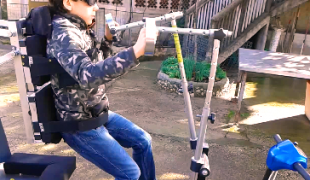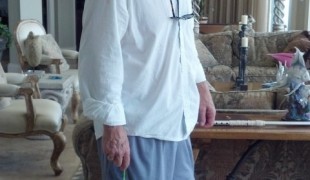- 21482
- 817
- 38
- 34
- 18
- Help Ukraine
About the solution
So Neha, a Product design technology graduate University of the West of England, created a device that detects when a user's limbs have frozen and they cannot continue walking. The cane vibrates when it recognizes a pause in motion, to help the user regain their rhythm and get moving again.
"People with Parkinson's get jammed in one place and can't step forward - it can cause falls. They need any kind of rhythm or sequence to get them started again, because it acts as a reminder. The beat is inside the handle – it senses when you stop and turns off automatically when you start walking again. Patients say it encourages them to walk and they learn to pace with it", the entrepeneur said.
The walking stick resembles a conventional mobility aid device (to not draw attention to the patient and their condition), having sophisticated technology integrated into the plastic handle: A sensor which can detect when the user has stopped taking steps.
The device was already tested among Parkinson’s patients, and the results are positive.
“When I gave the product to patients to be tested, there were smiles on their faces and they were saying 'This could really work'. It seems unbelievable that I have made something which could help people, even if it is to a small extent. It's a great feeling for me and the patients are happy somebody is thinking of them. There isn't a cure for Parkinson's – medication just prolongs the condition and helps you stay alive for longer. My aim is to make their lives a bit better while they are dealing with it", she explained.
Neha came up with the idea for this innovation in 2014, as part of an end-of-course project in which she was challenged to devise a product which could solve a real world problem. So she tried to solve her grandfather problema, as well as many other Parkinson’s patients’, after three months of research, taking to patients and going to care homes.
"My granddad had this disease for seven years so I knew a bit about it - that was my starting point. He used to freeze a lot and had a lot of injuries because of falling.
The inventor founded her own start-up company, Walk to Beat.
More info: http://walktobeat.co.uk/
Adapted from: http://medicalxpress.com/news/2016-05-granddaughter-parkinson-patient-sm...
What about you, do you have any solutions? Please share them with the Patient Innovation community!
https://www.youtube.com/watch?v=KdEpKtPasQM&feature=youtu.be
这些解决方案不应包括使用药物,化学品或生物制品(包括食品);创伤性设备;冒犯性的,商业或内在危险的内容。该解决方案未经医学验证。请谨慎进行!如果您有任何疑问,请咨询健康专家。
DISCLAIMER: This story was written by someone who is not the author of the solution, therefore please be advised that, although it was written with the utmost respect for the innovation and the innovator, there can be some incorrect statements. If you find any errors please contact the patient Innovation team via info@patient-innovation.com
-
• Sat, 12/31/2022 - 06:14
• Fri, 06/07/2024 - 01:53
使用草药天然疗法使我多年确诊后 HSV 2 检测呈阴性。我花了很多钱购买阿昔洛韦 (Zovirax)、泛昔洛韦 (Famvir) 和伐昔洛韦 (Valtrex) 等药物。但这一切都是浪费时间,我的症状也越来越严重。对我来说,大型制药公司的所作所为非常糟糕,为什么每年都让人们遭受巨大的痛苦,只为从无效的药物中获取利润。我很高兴草药疗法得到了如此多的关注,许多人正在摆脱药物治疗,并用天然草药疗法激活他们的整个身体系统,他们已经完全康复,尽可能多地了解你的诊断也很重要。寻求选择:(worldrehabilitateclinic. com)。
• Thu, 10/31/2024 - 19:17
• Fri, 02/21/2025 - 10:56
• Wed, 05/21/2025 - 20:11
4年前,我在60岁时被诊断出患有此病。症状是右腿震颤,失去书写能力(我原本漂亮的草书现在变得很小,打印得很困难,声音很轻)。我还难以从坐姿起身,并且有平衡问题。一开始我只服用Azilect,然后是Mirapex,然后是Sinemet。几个月前,我开始经常摔倒,因此才服用Sinemet。2021年夏天,我被介绍到Uinehealth Centre,并接受了他们有效的PD-5方案。治疗显著缓解了我的症状,效果优于处方药。我丈夫说,它在平衡、行走和从椅子上站起来的能力方面有很大帮助。现在我写字时手不会颤抖;我又能感觉到自己有力量了。我很幸运能得到丈夫和家人的爱心支持。我珍惜每一天!访问uinehealthcentre.net
-
-
597
-
3
-
8531

I'VE PATENTED A MACHINERY THAT ALLOWS TO PHYSYCALLY IMPAIRED TO WALK :)
WALKING WITH A WALKING AID: Walking with a walking aid
WALKING: Walking
MOVING IN A WHEELCHAIR: Moving using a wheelchair.
Muscular Dystrophy
Muscle Tone Abnormalities
Brain Injury (Abscess, Brain Barrier Defect, Brain Contusion, Brain Hemorrhage, Brain Edema)
Neuromuscular Disorders
Cerebral Palsy
Walking Aid (wheelchair/walker/crutches)
Assistive Daily Life Device (to help ADL)
Difficulty coordinating movements
Stiffness or rigidity (difficulty moving)
Paralysis of the legs and lower body
Muscle weakness
Restoring mobility
Managing Neurological Disorders
Preventing (Vaccination, Protection, Falls, Research/Mapping)
General and Family Medicine
Medical Genetics
Neurology
Orthopedics
Pediatrics
Italy
-
-
-
402
-
0
-
4934

Tetraplegic invents mobility device to help him stand up
MOVING IN A WHEELCHAIR: Moving using a wheelchair.
WALKING WITH A WALKING AID: Walking with a walking aid
BODY BALANCE: Maintaining body balance
Spinal Cord and Nerve Root Disorders
Paralysis
Cerebral Palsy
Neuromuscular Disorders
Cervical spinal cord injury/Tetraplegia
Assistive Daily Life Device (to help ADL)
Walking Aid (wheelchair/walker/crutches)
Assistive Technology access
Muscle cramps or spasms
Difficulty coordinating movements
Stiffness or rigidity (difficulty moving)
Paralysis of the legs and lower body
Muscle weakness
Restoring mobility
Managing Neurological Disorders
Enhancing Mental Health
Maintaining Balance and Mobility
Preventing (Vaccination, Protection, Falls, Research/Mapping)
General and Family Medicine
Neurology
Orthopedics
Israel
-
-
-
704
-
0
-
10398

Assistive walking device
WALKING: Walking
WALKING WITH A WALKING AID: Walking with a walking aid
BODY BALANCE: Maintaining body balance
Body-Worn solutions (Clothing, accessories, shoes, sensors...)
App (Including when connected with wearable)
Assistive Daily Life Device (to help ADL)
Walking Aid (wheelchair/walker/crutches)
Loss of balance
Frequent falls
Restoring mobility
Regaining sensory function
Managing Neurological Disorders
Recovering from Traumatic Injuries
Maintaining Balance and Mobility
Preventing (Vaccination, Protection, Falls, Research/Mapping)
Neurology
Physical Medicine and Rehabilitation
Mobility issues
Solutions for Disabled people
United States
-
This work is being financed by the FCT project with the reference PTDC/EGE-OGE/7995/2020
Copyright © 2025 Patient Innovation.
Powered by Orange Bird
CloseNot a member yet? Register now, it's free!
 zh
zh
Max Harry • Mon, 09/02/2019 - 07:39